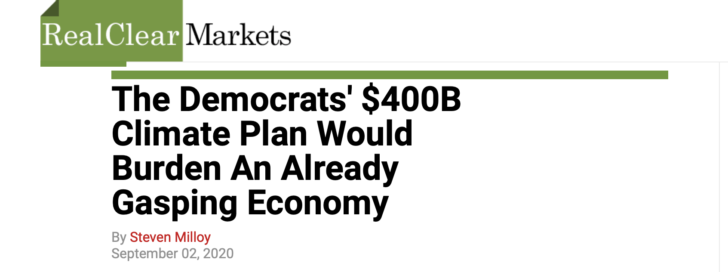My column at RealClearMarkets.com.

The Democratic Party has made it clear that they would rather pursue their destructive green agenda which further sets back America’s economy than give Americans the lifeline they need to get back on their feet. And if they flip the Senate this November, their climate tax will prove it.
Last week, Senate Democrats unveiled a climate plan that they say will cost $400 billion per year. But for a nation in recovery – one that is exhausted under the coronavirus pandemic, rebuilding after a deadly hurricane in Louisiana, and restoring businesses run into the ground from the recent shutdowns and lootings – it’s important to note what this climate plan really means for the average American household, and further, what it says about Democrats.
To estimate costs, there are about 120 million households in America. So, $400 billion per year divided by 120 million households means the Democrat climate spending plan is about $3,300 per year or about $280 per month — after taxes — for the average household per year.
And of course, actual costs are likely to be higher. They always are.
Under a Democrat-controlled America, citizens would be forced to pay more for gasoline and electricity, and higher energy prices would ripple throughout the economy forcing businesses to raise prices on all goods and services.
Average household income in the US was about $63,000 pre-COVID. The after-tax take home pay for the average household is then about $40,000 per year or 3,300 per month – once again, that’s pre-COVID.
So the Democrat climate plan is roughly an 8.5% tax increase on the average household on take home pay.
But maybe it’s worth it to save the planet? Well, let’s see.
Keeping in mind that the Democrat climate plan wouldn’t zero-out CO2 emissions until 2050, let’s pretend that we zeroed out US emissions today and forever.
Global manmade emissions of greenhouse gases are about 56 billion tons per year. The US share of that is approximately 7.5 billion tons – only 13% of total global emissions – which continues to shrink as Asia and Africa develop. The math shows that if America stopped emitting today, and never emitted again, atmospheric levels of carbon dioxide (CO2) would only be slightly reduced – possibly 545 parts per million (ppm) of CO2 vs. 529 ppm by the year 2100 (link sources for CO2 ppm).
There is no existing climate model that shows there will be any discernible difference in climate or weather due to that small change in atmospheric CO2.
So what the does the average household get for the Senate Democrats’ 8.5% take-home pay climate surtax? Absolutely nothing. No change in climate. No change in weather. Just higher prices and less money to spend.
You might be thinking, who in the world thinks this is good policy? That’s a great question.
A recent Harris poll placed climate as one of the lowest priorities for American adults — 23rd out of 24, to be exact. But it gets worse.
About a year ago, the Washington Post and Kaiser Foundation did a climate poll that included willingness-to-pay questions. When asked if they were willing to pay $2 more per month on their electric bill for climate, 51% of respondents said ‘No.’ When asked if they were willing to pay $10 more per month on their electric bill for climate, 71% of respondents said ‘No.’
And those questions and responses were not prefaced with the warning that the extra money you would pay would not accomplish anything even noticeable, let alone of value.
Had the pollsters asked about spending $3,300 per year on climate for nothing, you can well imagine what the response would be.
Democrats don’t usually discuss the details of their climate plans and it’s obvious why. No one wants to pay their hard-earned money for painful policies that won’t accomplish anything.
Steve Milloy publishes JunkScience.com, served on the Trump EPA transition team and is the author of “Scare Pollution: Why and How to Fix the EPA” (Bench Press, 2016).